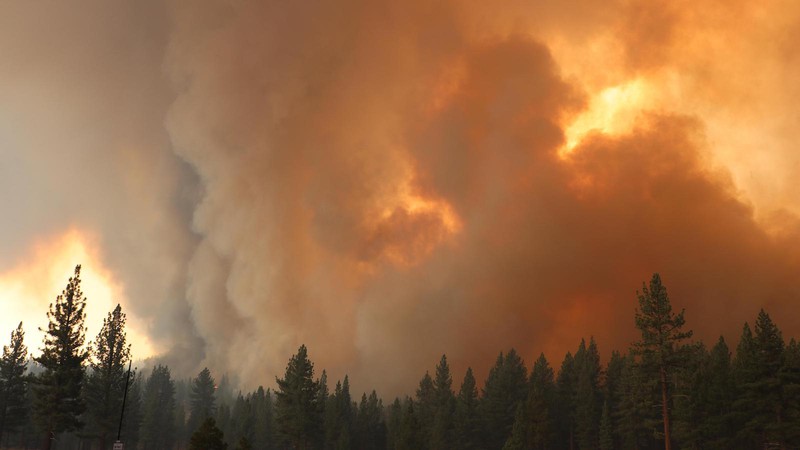Two new studies show climate change is the primary force causing more severe wildfires.

If policymakers accelerate efforts to slow climate change, California could get some relief from wildfires. Missvain / Wikimedia Commons Public Domain
California had one of its wettest winters on record in 2022 and early 2023, and the ongoing dampness, at least as of early July, was sparing the state from another devastating season of wildfires. The unusual number and fast pace of winter storms, scientists said, was directly connected to climate change.
“Nearly all of the observed increase in (burned area) over the past half-century is attributable to anthropogenic climate change.”
But the warming global climate, caused primarily by human use of fossil fuels, is also the force behind the increasing severity of California’s wildfires over recent decades, with the amount of acreage burned rising steadily since 1950. As of the year 2020, eight of the 20 largest wildfires in California history happened in the previous three years.
Two new studies by scientists at several California research institutions, as well as universities in other states and abroad, confirm that human-caused climate change is indeed the driver behind the increasing severity of wildfires in the state—and has actually made wildfires five times bigger over the past five decades.
Natural Climate Change Has ‘No Detectable Influence’
“Nearly all of the observed increase in (burned area) over the past half-century is attributable to anthropogenic climate change,” wrote the authors of one of the studies, published in the prestigious Proceedings of the National Academy of Sciences in June. (The term “anthropogenic” refers to pollution caused by human activity.)
The study—involving researchers from Lawrence Livermore National Laboratory, UCLA, UC Irvine, UC Merced and others—employs a type of research called attribution science which is designed to determine the connections between severe climate events and climate change by comparing real world data to data from a counterfactual world, simulated by computers, in which anthropogenic climate change does not exist.
Simulations including climate change showed 172 percent more burned land area than the imaginary world in which climate change didn’t exist.
They also ran simulations that include climate change, and those models closely matched the results of actual California wildfires since the early 1970s, with total burned area steadily increasing over the five decade period. But in the simulations that removed anthropogenic climate change from the model, the increases vanished.
In fact, the simulations including climate change showed 172 percent more burned land area than the imaginary world in which climate change didn’t exist. The increases caused by human-produced climate change really kicked in around 2001, according to the study. Naturally occurring changes in climate had “no detectable effect” on the increase in burning wildfire, the study found.
The study did not bode well for the future, either. According to the study’s findings, the amount of California land burned by wildfire could be up to 52 percent more than current averages for the years 2031 to 2050. But if there’s any good news from the new study, it’s that things don’t have to be this way. If governmental policymakers can quickly accelerate their efforts to reduce greenhouse gas emissions, California’s fast-growing wildfire problem can be brought under control.
“The results show the role of human-caused climate change in driving fire activity and highlight the need for protective adaptations against summer wildfire seasons,” Livermore Lab scientist Don Lucas, one of the study’s co-authors, said in a statement accompanying publication of the research paper.
Economic Consequences for Homeowners
The steadily surging wildfires have direct consequences for California homeowners. Namely, it has become a lot harder to buy homeowner’s insurance. Since November of 2022, two of the state’s largest insurers, State Farm and Allstate, have stopped taking on homeowner’s policies citing the increased wildfire danger.
“The results show the role of human-caused climate change in driving fire activity and highlight the need for protective adaptations against summer wildfire seasons.”
LIVERMORE LAB SCIENTIST DON LUCAS
A study by the U.S. Forest Service found that home values drop by an average of 10 percent after a wildfire in the vicinity, and if there’s a second fire in the vicinity, values plunge by 23 percent.
Researchers in a separate study, published in May by the International Journal of Wildland Fire, looked at actual wildfires between the years 1980 and 2020, correlating them with changes in the environment during that span. They found that "climate change is an overarching factor" in making fires more severe, according to Glen MacDonald, a UCLA environmental sustainability professor who is a co-author of the study.
The two main environmental factors causing wildfires to get more and more severe, the study found, are “increasing temperatures and atmospheric vapor pressure deficit.” That “deficit” is the difference between how much moisture the atmosphere can hold, and how much it actually does hold. The deficit is "an important predictor of wildfire potential in California,” the study says. And the deficit—that is, the dryness of California air—has been increasing at a “statistically significant rate” since 1979.
According to the study, about 68 percent of the increase in dryness is caused by climate change.